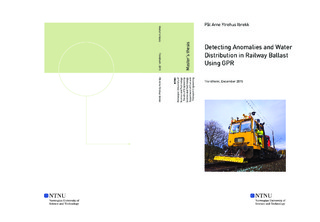| dc.description.abstract | Ground Penetrating Radar has seen increased interest in recent years as an efficient non-destructive method of railway track surveying. As a response, it is necessary to establish the scope of its abilities for this application.
The purpose of this thesis is to assess the abilities of a GPR system to detect anomalies like ballast pockets, and to map the distribution of water in railway ballast. In addition, the thesis itself is meant to serve as a comprehensible introduction to the field of GPR surveying, as well as an update on the latest research on its railway applications.
The work has consisted of an extensive literature review and field tests performed on a live railway track.
Literary sources describe GPR as a versatile system, with many areas of application and significant advantages over current inspection methods. Ballast thickness, fouling levels and buried objects can all be detected with relative ease, and recent advantages in data processing techniques have expanded the scope of applications further.
Field surveys confirmed the utilised GPR-system's abilities to accurately detect several subsurface track anomalies, and all the necessary features to reveal ballast pocket occurrence. This was accomplished with a minimal level of system customisation and post-processing of data.
Water distribution mapping abilities were indicated from the literature review, however, field study results were only partly conclusive due to unfavourable testing conditions (rain). While the test results seemed to indicate the waters propagation, the GPR's abilities could not be decisively confirmed.
Further studies are recommended to confirm the findings of this thesis and to further explore the scope of railway applications for GPR systems. | |

